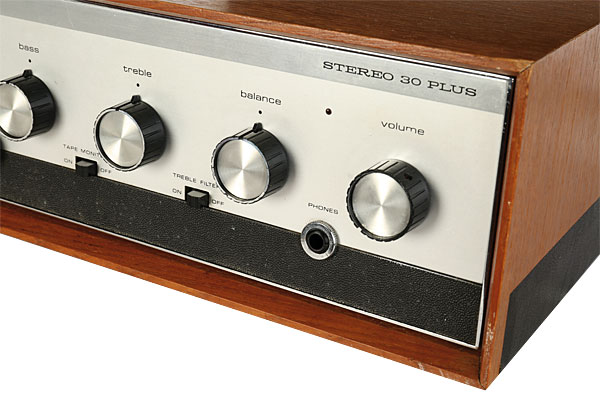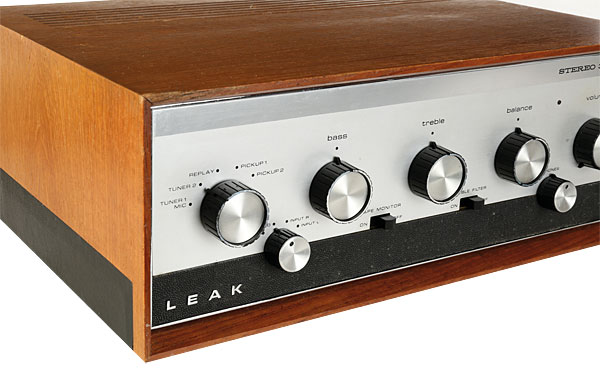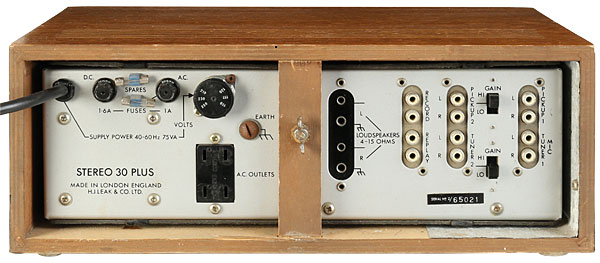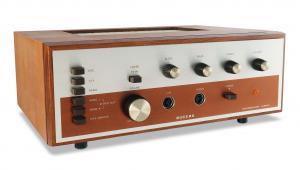Leak Stereo 30 Plus amplifier

 While a near dead-ringer for the amp it replaced, this '60s integrated saw Leak leverage new technology to boost performance and widen its appeal. How does it sound today?
While a near dead-ringer for the amp it replaced, this '60s integrated saw Leak leverage new technology to boost performance and widen its appeal. How does it sound today?
It's not unusual for a successful hi-fi product to be updated with mild revisions during its lifetime. Often the changes are minimal: a tidied-up fascia to match a new model added elsewhere in the range, or an extra function or minor circuit redesign. This was certainly not the case with the Leak Stereo 30 Plus amplifier of 1969, which replaced the Stereo 30 [HFN Oct '10] first seen in 1963. Side by side the two looked much the same, but inside the 30 Plus was all new in order to take advantage of improved technology.
The Big Switch
The Stereo 30 was Leak's first transistor amplifier. The number '30' equated to the sum of the outputs of both channels when measured under the most favourable conditions. Two lots of 15W easily trumped the outgoing Stereo 20 valve model, even before the improvements in reliability and performance due to the elimination of the output transformer (both key claims by Leak at the time) were taken into account.
The Stereo 30 used germanium transistors because that was all that was available at the time. They worked but were noisy and prone to thermal runaway, making it a challenge to design practical hi-fi amplifier circuits using them. Nevertheless, the Stereo 30 was well regarded and sold successfully until the appearance of silicon transistors in the middle of the decade signalled a step change in amplifier performance. Quieter and more stable, silicon made it possible to build high-gain, high-power circuits with relative ease. The Stereo 30 Plus was essentially the original concept built around a complete lineup of silicon devices. It was the same, only better.

The original amp had been built on a single PCB that carried almost the entire circuit. This was replaced with a hand-wired aluminium chassis onto which four edge-connector slots were mounted, the metalwork also forming the heatsink for the output transistors. The slots were home to four small PCBs, one preamp module and one power amplifier module per channel. This change certainly makes servicing beautifully straightforward.
Another Hit
Meanwhile, the output transistors used were the classic RCA 2N3055, the basis for many classic transistor amps of the period such as the Quad 303 [HFN Jul '11], B&O Beolab 5000 [HFN Oct '13] and Braun Regie 510 [HFN Jun '16]. Capable of dissipating up to 115W of heat, these transistors allowed reliable amplifiers of up to around 60W output to be constructed. Rated at just a quarter of this, the Stereo 30 Plus hardly stressed them at all, pointing towards durability.

The controls also better matched a typical user's needs. The complicated filter dial and variable slope selector were replaced with a simple top-cut switch. This allowed the balance control to be made the same size as the other major knobs and simplified operation. The largely pointless tape-head input was replaced by one for a tape machine having built-in amplifiers and the mic input was repurposed to accept a second tuner, although it was possible to convert this back if so required.
Finally, improvements were made to the turntable input too, with proper matching for standard MM cartridge types while the addition of a headphone socket reflected that types suitable for stereo listening had now become widely available.
The Stereo 30 Plus was another big hit for Leak. The company was later absorbed by the giant Rank organisation and the Stereo 30 Plus was replaced by the Delta 30, a restyled version of what was essentially the same design. What had once been the UK's leading hi-fi brand went into terminal decline shortly after this, being unable to compete with imports from Europe and Japan.
The Stereo 30 Plus may look reasonably conventional, but since it dates back to the early days of hi-fi there are inevitably some differences between the way it works and the way things are done today. This should not be a concern though, as the user manual is among the best I've ever encountered. Clearly written, a full circuit diagram and basic fault finding instructions are also included. Why can't manufacturers produce literature of this quality today?

Choosing Inputs
To use the Stereo 30 Plus optimally it is vital to understand how each input operates. The complete preamp circuit comes before the volume control so high-level sources, like CD players, will overload it if the wrong input is chosen. The RIAA stages are always in the signal path but their response and gain are flattened by the switching-in of different feedback circuits when the tuner and tape inputs are chosen.
For LP listening the most useful input is 'Pickup 1' as this is RIAA equalised and applies the correct loading of 47kohm to the cartridge. The 2mV sensitivity of this input is also ideal. A second RIAA-equalised input ('Pickup 2') is optimised for other cartridges, such as ceramic and variable reluctance types. It offers two sensitivity settings, neither of which suit modern cartridges, so this is best ignored.

Of the tuner inputs 'Tuner 2' offers two sensitivities, the lower one (250mV) being just about suitable for a CD player whereas the high-sensitivity setting (60mV) is useful for portable equipment whose output is typically lower than the nominal 2V CD player standard. 'Tuner 1' was primarily intended for Leak's own Troughline series, which has a low output level and the 25mV sensitivity of this connection is too high for most conventional equipment.























































